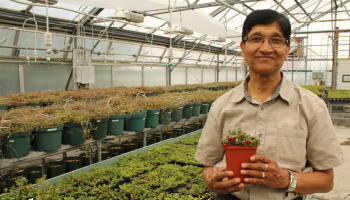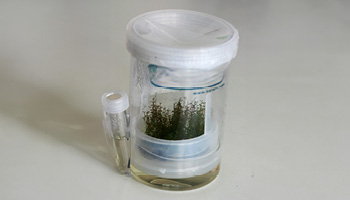For more information
Media Relations
Agriculture and Agri-Food Canada
1-866-345-7972
aafc.mediarelations-relationsmedias.aac@agr.gc.ca
Lingonberry, a shrub native to northern regions of Canada, produces small, tart and slightly sweet berries known for their health benefits. It is a close relative of the blueberry and cranberry, but richer in the healthy antioxidant “anthocyanins”.
Recent research by Agriculture and Agri-Food Canada (AAFC) shows that eating lingonberries can reduce risk of kidney, liver, and heart disease.
This super food could have super potential for Canadian producers. That is why AAFC research scientist Dr. Samir Debnath, from the St. John's Research and Development Centre in Newfoundland and Labrador, is searching for methods to speed up the development of new lingonberry varieties and increase production of lingonberries suitable for northern agricultural systems.
Big results with micropropagation
Dr. Debnath and his team collected wild lingonberry plants throughout Atlantic Canada, Quebec, the United States, and Europe, to create a North American repository for wild lingonberry. He was then able to use antioxidant-rich plant germplasm (hereditary genetic material) to multiply lingonberries year-round in St. John’s, with a modified breeding method he developed.
Dr. Debnath and his team produce new plant varieties through micropropagation with an added twist. Micropropagation is a process that uses very small pieces of plant tissue taken from a mother plant, and then growing them in a lab to produce new plants. The difference is that Dr. Debnath also uses bioreactors, which are self-contained, controlled, and sterile environments for rapid plant growth. In these bioreactors, protecting them from disease, leaves and stems taken from native lingonberry plants grow numerous shoots that, once transplanted, become new lingonberry shrubs. This technology can produce thousands of plants from a single sample of the mother plant.
“Normal multiplication without bioreactor technology would take many years, 16 or more, and many resources. Using the micropropagation process with bioreactors we could have a thousand plants in a single vessel and speed up development of new berry varieties by 10 years or more.”
- Dr. Samir Debnath, research scientist, Agriculture and Agri-Food Canada
Aside from its ability to push the breeding process into hyper-speed, another big advantage of micropropagation is that it preserves the genetic quality of all new plants. This is because new plants produced in this way are genetically identical (perfect clones) to the mother plant, unlike wild lingonberry plants. Micropropagation can also be used for developing new varieties of other berry species like blueberry, cranberry, strawberry, and raspberry.
Combining the best of two worlds
With this modified breeding process, Dr. Debnath developed hybrid lingonberry varieties that combine the high antioxidant levels of Canadian varieties with the high yield potential of European varieties. These hybrids can also be grown in slightly warmer areas that are more suitable for agricultural production. They are currently being evaluated in farm fields in Newfoundland and Labrador, Manitoba, and Quebec by researchers from AAFC, the province of Newfoundland and Labrador, and local producers.
“Our hybrid varieties combine the best of both worlds. We are expecting to have good results from these research trials in the next few years.”
- Dr. Samir Debnath, research scientist, Agriculture and Agri-Food Canada
This research is paving the way to develop high genetic quality berry plants with fruits and leaves of high nutritional and medicinal value, for northern agricultural systems. As Dr. Debnath’s world leading research on new propagation methods advance, lingonberry could one day become an important crop in Canada.
Key discoveries and benefits
- Recent research by Agriculture and Agri-Food Canada shows that eating lingonberries can reduce risk of kidney, liver, and heart disease.
- AAFC research scientist Dr. Samir Debnath, from the St. John's Research and Development Centre in Newfoundland and Labrador, is searching for methods to speed up the development of new lingonberry varieties and increase production of lingonberries suitable for northern agricultural systems.
- Dr. Debnath and his team produce new plant varieties through micropropagation with an added twist. Micropropagation is a process that uses very small pieces of plant tissue taken from a mother plant, and then growing them in a lab to produce new plants. The difference is that Dr. Debnath also uses bioreactors, which are self-contained, controlled, and sterile environments for rapid plant growth. In these bioreactors, protecting them from disease, leaves and stems taken from native lingonberry plants grow numerous shoots that, once transplanted, become new lingonberry shrubs. This technology can produce thousands of plants from a single sample of the mother plant.
- Through this modified breeding process, Dr. Debnath developed hybrid lingonberry varieties that combine the high antioxidant levels of Canadian varieties with the high yield potential of European varieties. These hybrids can also be grown in slightly warmer areas more suitable for agricultural production systems.
- They are currently being evaluated in farm fields in Newfoundland and Labrador, Manitoba, and Quebec by researchers from AAFC, the province of Newfoundland and Labrador and local producers.
Photo gallery

